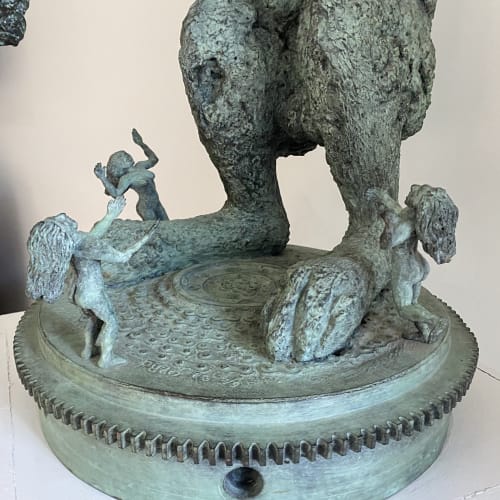SOPHIE RYDER, Hare with Dancers, 1998
Our featured artwork this week is an exceptional early bronze Hare with Dancers by Sophie Ryder. This work is from a 1998 sold-out edition, which the gallery offers for sale on behalf of a collector who is downsizing. A fine example of Ryder’s art, this sculpture has a slightly unusual subject matter. Instead of a more frequent portrayal of Lady Hare featuring physical traits of both human and animal, the artist focused on a naturalistic representation of a hare, while dancing ladies around it are notably inferior in size, which takes this composition into a fantastical and allegorical plane.
Sophie’s imaginary world is populated by mystical hybrid creatures bound together in intimate and affectionate companionship. Although best known for her large-scale outdoor wire sculptures, Ryder uses many other materials - bronze, wet plaster embedded with old machine parts, sheet metal, marble, and stained glass. Drawing, painting and printmaking have always been central to her artistic practice and are a vital creative counterpoint to her sculptural work. Sophie Ryder's work is instantly recognizable and she is one of Britain’s most well-known sculptors. Over the last 30 years, she has built a personal repertoire of mythological figures and motifs, many examples of which are now in important public and private collections, particularly in the UK and USA. Tender and self-aware, her hybrid creatures encapsulate mythology’s significance: steeped in cultural symbolism, they nevertheless resonate on an immediate and human level. Her compositions address a complex range of human emotions, from introspection to desire.
Sophie Ryder's mythical sculptures belong to a world that is all their own. Whether dancing in bronze or embracing in her signature steel wire mesh, her enduring characters bear a sense of familiarity and history that is ultimately rooted in her artistic practice. Her work does echo art's history. The Minotaur, for instance, originates in the myths of Minoa, and Ryder's more tender, loving figure is indebted to Picasso's interpretation. Meanwhile Ryder's highly personal counterpoint to the Minotaur, the Lady-Hare, might be seen to draw on a very different strand of mythology, English rural mysticism, harnessing the nocturnal animal's association with the cycles of the moon, fertility and feminine sexuality. Yet any symbolism in her work is largely subliminal and the logic at each character's core is intuitive, a reflection of Ryder's deep love of nature and incisive understanding of the human condition.
Wild and organic, the seeds of Ryder's distinctive sculptures are immediately discernible in her personal world. The child of a French mother and English father, she enjoyed a rather Bohemian upbringing, spending long summers on her mother's farm and vineyard in the south of France, largely without the constraint of any clothing. Her remarkable home in the Cotswolds, Lampits Farm, is willfully rustic. Both her home and a showcase for her monumental and small-scale sculptures, the space was lovingly crafted by Ryder and her former husband. They heaved stone from the land by hand to make bricks, bought 10 Cotswold roof tiles and made molds to cast their own, made all doors and windows on site, and Ryder forged all of the metalwork herself. They even planted 4,000 trees to create the woodland that Ryder now runs around daily, accompanied by her beloved lurcher dogs.
Yet Ryder's sculptures do not simply reflect nature. Like the most enduring myths, their wild forms embody human feelings and relationships. This is perhaps most palpable in the Lady-Hare, whose female body is based on Ryder's own. A deeply personal character for the artist, she allows her anonymity and complete openness in her incisive explorations of emotion, love and sexuality. Distilling feelings and relationships into wild, magical forms, her sculptures show us our own inner states with newfound clarity and joy.
Her work has followed a personal and organic trajectory, growing in ambition and scale along with her own technical ability. Her unique materials add a layer of intrigue, with twisted wire, wet plaster and sawdust joining old machine parts and bits of scavenged children's toys in exquisitely textured sculptures. When asked about what influences her, Ryder replies, "I don't sit and contemplate what it is I am trying to achieve. My head is full of ideas all the time. It is part of my life. I don't plan anything, it just comes." When asked why she portrays hares she replied, "Well, I find it difficult answering that question because I don't really know the answer. It's the same as asking me why I make sculptures, and the answer is, because I feel driven to. So it's difficult to always pin down reasons. My introduction to hares was when my lurcher dog would proudly bring hares home and drop them at my feet."
Ryder’s work has been the subject of numerous solo exhibitions since the late 1980s, including shows at Berkeley Square Gallery, London; Cartwright Hall Art Gallery, Bradford; Frederick Meijer Gardens & Sculpture Park, Grand Rapids; Galerie de Bellefeuille, Montreal; Newport City Museum & Art Gallery; Odapark, Venray, Netherlands; Salisbury Cathedral; Victoria Art Gallery, Bath; and Yorkshire Sculpture Park. Public and corporate collections that hold her work include Barings Bank; Cheltenham Art Gallery & Museum; De Beers Collection; The National Trust; The Private Bank and Trust Company Ltd; Robert and Mary Montgomery Armory Arts Center, Palm Beach; and Victoria Art Gallery, Bath. Waterhouse & Dodd helped to organize Sophie’s first museum exhibition of the USA at the Ann Norton Sculpture Gardens in West Palm Beach in 2017.
SOPHIE RYDER
Hare with Dancers, 1998


